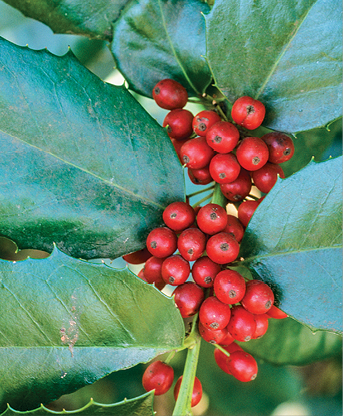1. Mountain Laurel

Name: Kalmia latifolia and cvs.
USDA Hardiness Zones: 5 to 9
Size: 8 to 15 feet tall and wide
Conditions: Full sun to partial shade; moist, humus-rich, acidic, well-drained soil
Yes, mountain laurel will, indeed, prosper in southern coastal gardens. Clusters of cup-shaped pink blooms make it one of our most showstopping native shrubs and a guaranteed garden conversation piece. Give it room to spread and conditions akin to those it prefers in the wild—moist mountain slopes or cool, shady riverbanks—and you will be rewarded with a graceful, beautiful, sculptural shrub. Apply mulch to help retain soil moisture and to keep its roots cool. For the best results, seek out nurseries that propagate it from local populations.
2. Purple Anise

Name: Illicium floridanum and cvs.
Zones: 7 to 9
Size: 6 to 10 feet tall and 5 to 8 feet wide
Conditions: Partial to full shade; moist to wet soil
Visitors to your garden will do a double-take when they spot the starburst maroon blooms of this tough native shrub. Purple anise occurs naturally in moist, shady woodland ravines and near streams, making it an excellent choice for wet areas in your yard. Place purple anise where its flowers may be appreciated up close, or naturalize it in your woodland garden. In sunnier areas, keep the plant wet. Many unusual cultivars are available, with variations in bloom color and leaf variegation. The fragrant leaves make this evergreen resistant to browsing deer.
3. Moonglow® Sweetbay Magnolia

Name: Magnolia virginiana ‘Jim Wilson’
Zones: 5 to 10
Size: 15 to 35 feet tall and 10 to 20 feet wide
Conditions: Full sun to partial shade; medium to wet, rich, acidic, well-drained soil
With its attractive, upright, multitrunked structure and silver-backed leaves that sparkle in the breeze, Moonglow® sweetbay magnolia is a true visual delight as a patio or specimen tree. This petite form of our native sweetbay magnolia is well suited for small spaces and is also more cold tolerant. Its lemon-scented, creamy white blooms are larger than the species, and the tree has no disease or insect problems. Moonglow® will tolerate a range of soil conditions, including wet areas and low spots in your garden. Its bright red seeds are showy and attractive to wildlife.
4. ‘Emily Bruner’ Holly

Name: Ilex ‘Emily Bruner’
Zones: 7 to 9
Size: 15 to 20 feet tall and 10 to 15 feet wide
Conditions: Full sun to partial shade; moist, well-drained soil
Having once gardened for Emily Bruner, I’ll always have a soft spot for this abundantly fruiting female holly. Along with an attractive columnar form and glossy, dark green leaves, low-care ‘Emily Bruner’ holly also has a coarse texture that causes it to stand out in the landscape a bit more distinctly than, for example, the popular ‘Nellie R. Stevens’ holly. It is handsome as a specimen, in groupings, or as a screen for a property line. And it’s deer resistant, to boot. To ensure berry production, plant nearby a male pollinator, such as a ‘John T. Morris’ or ‘Edward J. Stevens’ holly (I. ‘John T. Morris’ or ‘Edward J. Stevens’, Zones 6–9).
Patricia Drackett is director of The Crosby Arboretum at Mississippi State University in Picayune.
Photos: (1), Carl Johnson; (2), Bill Johnson; (3), Doreen Wynja; (3), Jerry Pavia; bottom right

















Comments
Log in or create an account to post a comment.
Sign up Log in